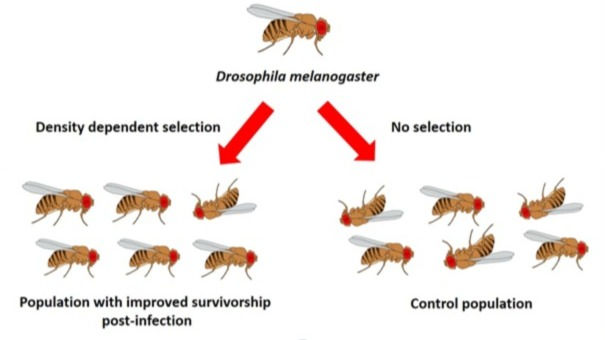ENVIRONMENT AND INSECT IMMUNITY
- Indian Entomologist
- Oct 7, 2021
- 3 min read
Updated: Dec 6, 2021
NEW FINDING SUGGESTS ADAPTATIONS TO LARVAL CROWDING LEADS TO EVOLUTION OF IMPROVED SURVIVORSHIP AFTER INFECTION
By Rahul Kumar
Availability of food and prevailing environmental conditions during critical developmental stages of an organism can have significant impact on its ability to fight infections as adult. Development and programming of immune system is affected by such early life events. Insects exhibit a robust innate immune response against pathogenic challenge. Innate immune response is conserved across entire animal kingdom. Though insects do not have an adaptive immune system, their innate immune response against pathogens are certainly influenced by the environment. Being a model organism, Drosophila melanogaster has been extensively used for studying insect immunity. Findings in Drosophila have wider implications in other invertebrates too. Many pathways discovered in Drosophila have a homologous pathway found in vertebrates as well. We know that in Drosophila two different immune response pathways are invoked by gram-negative and gram-positive bacteria. Gram-negative bacteria invoke immune response in Drosophila via IMD (acronym for “immune deficiency”) pathway which is highly conserved among insects as well as other arthropods. Gram-positive bacteria elicit immune response via toll pathway. Drosophila is a holometabolous insect. Its larval environment is confined nearby egg laying site. Most of the resource acquisition for development occurs at larval stages itself. Larval crowding subject the animal to multiple stress conditions like decreased nutritional uptake and exposure to high concentrations of nitrogenous wastes excreted by the larvae which negatively affects body size, fecundity, etc. in adults. Previous studies have found that adaptations to larval crowding may result in correlated evolution of traits like increase in adult life span but its impact on survivorship post-infection has never been studied before. In a recent study conducted by a group of Indian scientists, it has been found that larval population density has a positive impact on survivorship of the insect after infection.

Figure: Adaptations to larval crowding leads to evolution of improved survivorship in Drosophila melanogaster after infection via density dependent selection.
In this study, the scientists subjected different set of populations of Drosophila melanogaster to poor developmental conditions (larval crowding) for multiple generations (240 generations) against low density controls. Here larvae were grown at high density (crowded) and after becoming adults these were kept at low density (uncrowded). Survivorship post infection was measured after infecting different sets of population either by gram negative bacteria Pseudomonas entomophila or gram positive bacteria Enterococcus faecalis. These bacteria cause serious gut damage and systemic pathogenic infection. Survivorship measurements suggest enhancement in the abilities in the adults of Drosophila melanogaster subjected to larval overcrowding for multiple generations to fight gram negative bacteria Pseudomonas entomophila infections in comparison to the control group. This is an example of density dependent selection where correlated evolution of pathogen-specific increase in survivorship post-infection has been observed in the populations of Drosophila melanogaster as a result of adaptation to larval crowding environment. This is a novel finding which may be useful in understanding how density dependent selection acting on one stage in life of an organism can modify traits in other stages of its life. This finding has also opened a horizon to look into specific molecules associated with IMD pathway of immune response which may be involved in acquisition of post-infection survivorship trait and to decipher the detailed molecular mechanism behind such density dependent selection leading to post-infection survivorship.
For more details, please refer
Kapila R, Kashyap M, Poddar S, Gangwal S, Prasad NGG (2021). Evolution of pathogen-specific improved survivorship post-infection in populations of Drosophila melanogaster adapted to larval crowding. PLOS ONE 16(4): e0250055. https://doi.org/10.1371/journal.pone.0250055
Rahul Kumar is one of the Associate Editors of IE. He is working as Assistant Professor of Zoology at Department of Zoology, Sheodeni Sao College (Magadh University), Kaler-824127, Arwal, Bihar, India. You can contact him at rahuldayanand33@gmail.com.
Disclaimer: The contents, style, language, plagiarism, references, mention of any products if any, etc., are the sole responsibility of the authors.







Comments